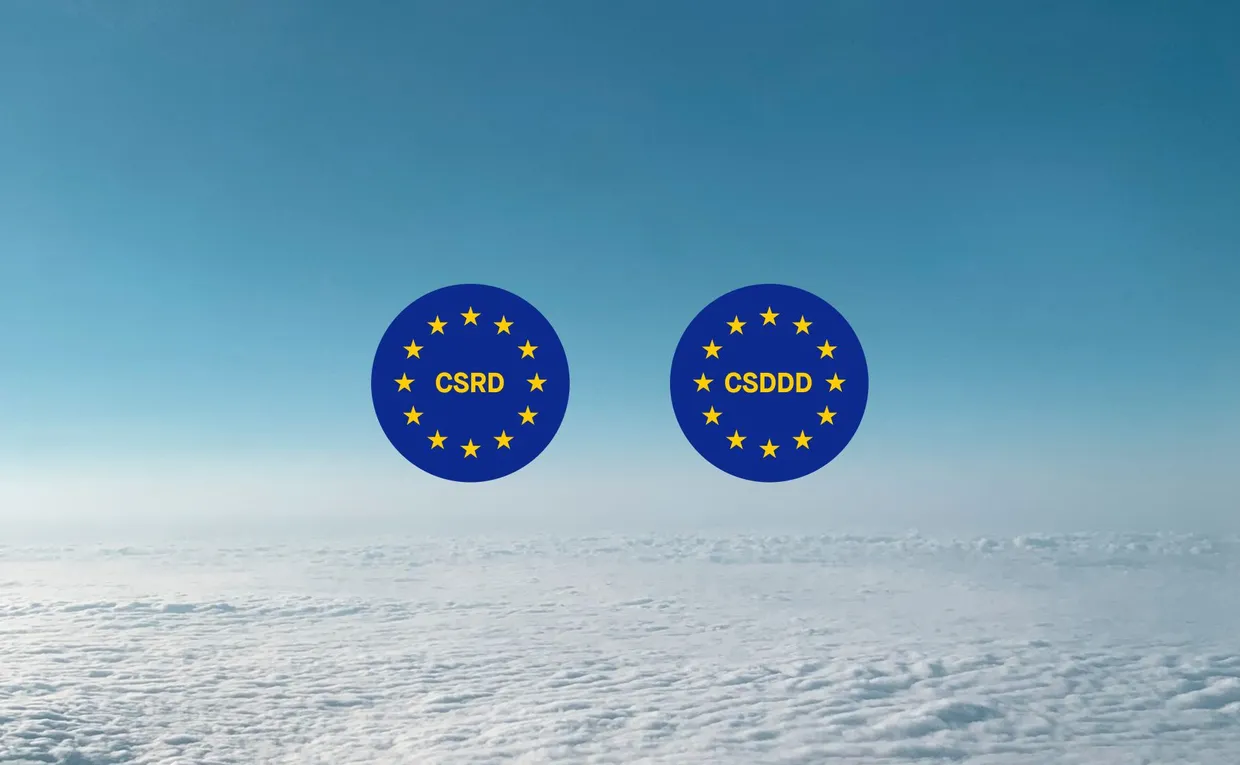The TCFD task force has officially been disbanded and the International Financial Reporting Standards (IFRS) will take over, with some changes to GHG reporting. The IFRS will offer a newer, more detailed framework for international ESG reporting, risk management and climate related financial disclosures.
The Financial Stability Board has announced that the work of the Task Force For Climate-related Financial Disclosures (TCFD) has fulfilled its remit. It will be replaced by the IFRS, a group established by the Financial Stability Board to develop recommendations on how companies should disclose their climate-related risks and opportunities. Let's take a look at what this means for the future of climate risk disclosures.
What is the IFRS?
The International Financial Reporting Standards (IFRS) is a non profit organization committed to implementing comprehensive and globally accepted sustainability disclosing standards. The new standards will be adopted from the International Sustainability Standards Board (ISSB).
IFRS is set to take over the monitoring of the progress of companies’ climate-related disclosures in 2024. The IFRS initiative will closely resemble the TCFD task force recommendations and standards with some changes and influence from the ISSB that calls for more detail and transparency on risk disclosures for different climate related scenarios.
TCFD – The cornerstone of climate related financial disclosures
The Task Force on Climate-related Financial Disclosures (TCFD) played a pivotal role in addressing the financial risks associated with climate change. Established by the Financial Stability Board, the TCFD outlined a framework for companies to disclose climate-related risks information in their financial filings and offered a benchmark for managing climate related risks. Its significance lay in fostering transparency and enabling investors, lenders, and insurers to make informed decisions by understanding the relevant climate-related risks and opportunities within a business.
The TCFD four pillars of climate related scenarios included:
-
Governance – Disclosing your company's governance around climate risks and opportunities.
-
Risk Management – Disclosing how the organization identifies, assesses, and manages climate-related risks.
-
Strategy – Disclosing the actual and potential impacts of these risks and opportunities on your strategy and financial planning.
-
Metrics and Targets – Disclosing your company's metrics and targets used to measure progress in mitigating climate risks and capitalizing on climate-related opportunities. Note that this also covers your transition plan, i.e. the actions and activities you'll undertake to achieve net-zero emissions by 2050.
The TCFD's recommendations provided a foundation for climate-related disclosure standards globally, influencing regulatory developments and shaping reporting requirements. Notably, it influenced the European Union's Sustainable Finance Disclosure Regulation (SFDR) and contributed to the growing momentum for standardized climate disclosure frameworks in financial markets worldwide.
The TCFD's impact extended beyond voluntary reporting, as its principles influenced legislative measures along with financial impacts, aimed at integrating climate risk considerations into mainstream financial reporting.
IFRS takes over the monitoring of climate related financial risks
Following the release of the inaugural standards, IFRS S1 and IFRS S2, the IFRS Foundation has been tasked by the Financial Stability Board (FSB) to take over the role of monitoring companies' progress on climate-related disclosures from the TCFD.
IFRS S1 and IFRS S2 comprehensively integrate TCFD recommendations, marking the culmination of the TCFD's work since its establishment in 2017 at the request of the FSB. With the International Sustainability Standards Board (ISSB) actively supporting the implementation of these standards globally, the IFRS Foundation will take over monitoring responsibilities from the TCFD.
What does IFRS S1 and IFRS S2 cover?
IFRS S1 and S2 collectively cover a comprehensive set of disclosure requirements to communicate sustainability-related risks and opportunities to investors.
IFRS S1 focuses on an organization's governance processes, strategy, risk management, and performance metrics related to sustainability. It ensures organizations disclose material information over short, medium, and long terms.
IFRS S2, designed to complement S1, delves into climate-related aspects, encompassing physical risks, transition risks, and opportunities. Both standards come with guidance on presentation, timing, and industry-specific considerations. Rooted in TCFD principles, these standards empower organizations to transparently convey their sustainability practices and align with the global shift toward comprehensive climate-related disclosures.
What are the key differences between the IFRS standards and the TCFD?
The key differences between IFRS Standards (ISSB S1 and S2) and the TCFD lie in their structure, requirements, and scope. Notably:
-
Comprehensive Coverage: Unlike TCFD, IFRS S1 captures sustainability-related issues beyond climate, ensuring a more holistic approach.
-
Scope 3 Emissions Reporting: IFRS S2 goes beyond TCFD by requiring comprehensive reporting on Scope 3 emissions, offering a more thorough perspective on a company's environmental impact.
-
Material Information Focus: IFRS S1 and S2 emphasize materiality, requiring disclosure of all material sustainability-related information. In contrast, TCFD adopts a principles-based framework, providing more flexibility.
-
Industry and Sector Specifics: ISSB Standards mandate industry and sector-specific disclosures, enhancing relevance and enabling effective benchmarking.
These distinctions emphasize the nuanced and detailed nature of IFRS Standards, providing a structured and replicable framework compared to TCFD's principles-based guidance. Adopting IFRS S1 and S2 ensures compliance with TCFD recommendations while offering additional insights into industry-specific metrics, carbon credit usage, and financed emissions.
Quantitative and qualitative disclosures
IFRS sets out criteria for climate related reporting – and when quantitative and qualitative climate related information is required. Disclosure of only qualitative information is permitted under some circumstances, for example, when a company cannot separately identify the effects of the risk, opportunity or when the level of measurement uncertainty involved is too high.
When preparing disclosures on the anticipated financial effects, IFRS requires asset owners to use all reasonable and supportable information that is available at the reporting date without financial implications or effort and requires the use of an approach that is commensurate with the company’s circumstances.
Further guidance on reporting emission scopes
There will be a separate disclosure of Scope 1 and Scope 2 GHG emissions in annual reports.
Scope 1: There will be a consolidated accounting group, for associates, joint ventures, unconsolidated subsidiaries or affiliates not included in the consolidated accounting group.
Scope 2: GHG emissions using a location-based approach and information about any contractual instruments that is necessary to inform users’ understanding.
Scope 3: Inclusion of additional information about company financed emissions. Examples being financial institutions with activities in asset management, commercial banking or insurance; and information about measurement approach, inputs and assumptions used in measuring Scope 3. There will be a standardized framework for Scope 3 emissions to prepare for the new climate risk disclosure requirements for annual reports coming in 2024.
Risk management processes
The TCFD required companies to identify and manage climate related risks. However, IFRS requires the disclosure of more detailed information related to these areas. For example: the input parameters it uses to identify climate related risks; data sources, the scope of operations the detail used in assumptions, whether the company uses climate-related scenario analysis to inform its identification of risks, and whether it has changed the processes used to identify, assess, prioritize and monitor the risk management process compared to the prior annual reporting period. IFRS also explicitly requires additional disclosures on the processes used to identify, assess, prioritize and monitor opportunities.
How can your company prepare?
-
Take the necessary steps to prepare for ISSB standards, by familiarizing yourself with the current TCFD pillars: governance and risk management, strategy metrics, and targets. Remember that the IFRS will be based on the work of the TCFD with further detail required for climate related financial disclosures in annual reports.
-
Assess your existing sustainability reporting practices and identify any gaps that need to be addressed to align with the ISSB standards. It's crucial to establish robust data collection and management systems to capture relevant sustainability information, including greenhouse gas emissions, climate risks, and opportunities.
By proactively preparing and aligning your reporting practices with the ISSB standards, you can enhance your transparency, credibility, and responsiveness to investor demands and regulatory requirements.
How Sweep can help
Find out more about how we can support you with your data management and compliance journey.



